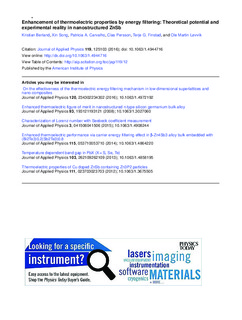| dc.contributor.author | Berland, Kristian | |
| dc.contributor.author | Song, Xin | |
| dc.contributor.author | Carvalho, Patricia | |
| dc.contributor.author | Persson, Clas | |
| dc.contributor.author | Finstad, Terje | |
| dc.contributor.author | Løvvik, Ole Martin | |
| dc.date.accessioned | 2017-06-29T08:16:45Z | |
| dc.date.available | 2017-06-29T08:16:45Z | |
| dc.date.created | 2016-03-31T14:58:34Z | |
| dc.date.issued | 2016 | |
| dc.identifier.issn | 0021-8979 | |
| dc.identifier.uri | http://hdl.handle.net/11250/2447313 | |
| dc.description.abstract | Energy filtering has been suggested by many authors as a means to improve thermoelectric properties. The idea is to filter away low-energy charge carriers in order to increase Seebeck coefficient without compromising electronic conductivity. This concept was investigated in the present paper for a specific material (ZnSb) by a combination of first-principles atomic-scale calculations, Boltzmann transport theory, and experimental studies of the same system. The potential of filtering in this material was first quantified, and it was as an example found that the power factor could be enhanced by an order of magnitude when the filter barrier height was 0.5 eV. Measured values of the Hall carrier concentration in bulk ZnSb were then used to calibrate the transport calculations, and nanostructured ZnSb with average grain size around 70 nm was processed to achieve filtering as suggested previously in the literature. Various scattering mechanisms were employed in the transport calculations and compared with the measured transport properties in nanostructured ZnSb as a function of temperature. Reasonable correspondence between theory and experiment could be achieved when a combination of constant lifetime scattering and energy filtering with a 0.25 eV barrier was employed. However, the difference between bulk and nanostructured samples was not sufficient to justify the introduction of an energy filtering mechanism. The reasons for this and possibilities to achieve filtering were discussed in the paper. | nb_NO |
| dc.language.iso | eng | nb_NO |
| dc.title | Enhancement of thermoelectric properties by energy filtering: Theoretical potential and experimental reality in nanostructured ZnSb | nb_NO |
| dc.type | Journal article | nb_NO |
| dc.type | Peer reviewed | nb_NO |
| dc.description.version | publishedVersion | nb_NO |
| dc.source.pagenumber | 10 | nb_NO |
| dc.source.volume | 119 | nb_NO |
| dc.source.journal | Journal of Applied Physics | nb_NO |
| dc.source.issue | 12 | nb_NO |
| dc.identifier.doi | 10.1063/1.4944716 | |
| dc.identifier.cristin | 1348073 | |
| dc.relation.project | Notur/NorStore: NN9180K | nb_NO |
| dc.relation.project | Norges forskningsråd: 228854 | nb_NO |
| dc.relation.project | Notur/NorStore: NN2615K | nb_NO |
| cristin.unitcode | 7401,80,64,0 | |
| cristin.unitcode | 7401,80,6,2 | |
| cristin.unitname | Materialer og nanoteknologi | |
| cristin.unitname | Materialfysikk. Oslo | |
| cristin.ispublished | true | |
| cristin.fulltext | original | |
| cristin.qualitycode | 2 | |
